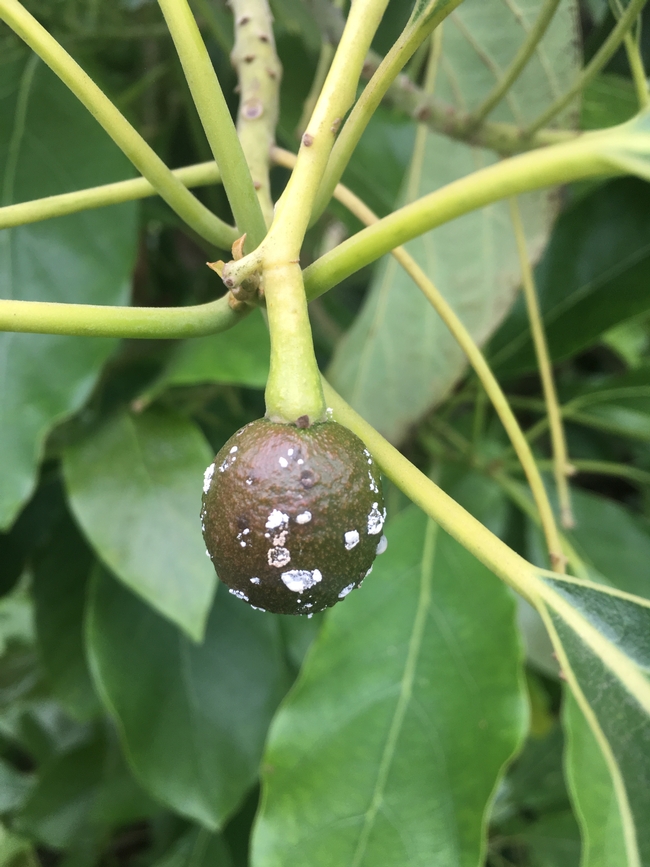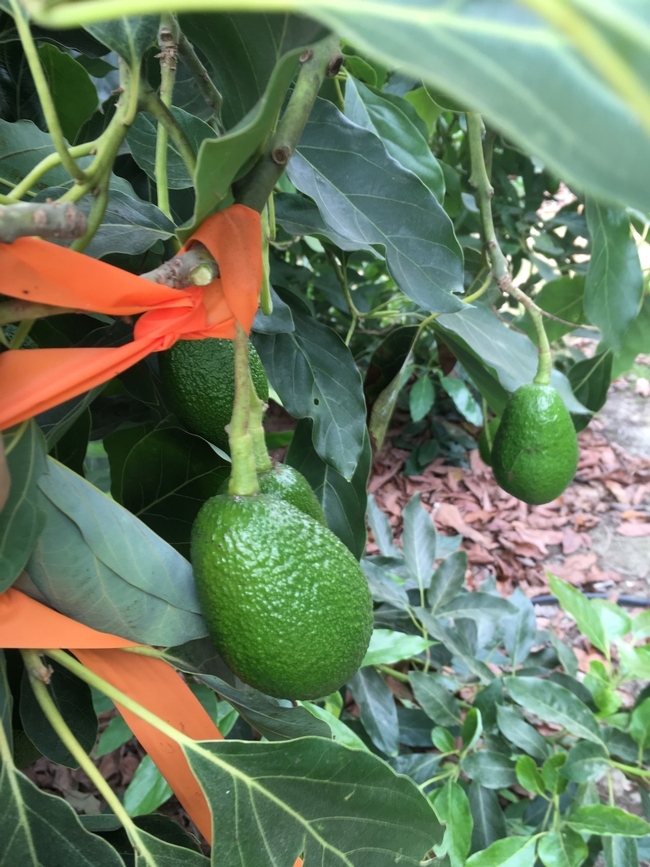In 'pond scum,' scientists find answers to one of evolution's which-came-first cases
Moths and butterflies existed during Jurassic era, millions of years before flowering plants, team reports
This means insects were just waiting for avocados and citrus to come along in order to start using them as a resource.
Chestnut Hill, Mass. (1/10/2018) - Visiting a colleague in Germany in 2012, Boston College Research Professor Paul K. Strother was examining soil samples for pollen, spores, pieces of plants and insect legs - organic debris that might otherwise have been considered "pond scum" when it was trapped in sediment during cataclysmic earth events 200 million years ago.
The slides of rock samples drilled in the German countryside included some material that looked familiar to Strother, a Department of Earth and Environmental Sciences researcher at Boston College's Weston Observatory, who studies the origin and early evolution of land plants. What he saw were features similar to those found in insect wings.
The wrinkle was that these types of moths and butterflies - known as Lepidoptera - were long posited to have evolved 50 to 70 million years later, during the Cretaceous period when the first flowering plants emerged as their prime food source.
"The consensus has been that insects followed flowers," said Strother, a co-author of "A Triassic-Jurassic window into the evolution of Lepidoptera," a new report published today in Science Advances. "But that would be 50 million years later than what the wings were saying. It was odd to say the least, that there would be butterflies before there were flowers."
Five years later, Strother and colleagues from natural history museums in Germany and a university in the Netherlands have developed a scientific case showing the Lepidoptera evolved earlier than previously established - emerging during the Jurassic period.
Absent flowers, the researchers report, primitive moths and butterflies, known as the Glossata, developed the physical attributes - namely the sucking proboscis - to find nutrition by drawing off water droplets from the tips of immature gymnosperm seeds.
"What we've found is that these butterflies and moths with mouth parts were feeding on pollen droplets of gymnosperm seeds - from conifers related to pines, seed plants without fruits and flowers. They were feeding off the cone-borne seeds - mainly as a source of water," said Strother.
Even Charles Darwin called the mysterious evolution of flowering plants "an abominable mystery." Scientists have reckoned that flowering plants preceded the insects that fed off of them. But researchers have gradually started to piece together evidence that moths and butterflies existed earlier than the Cretaceous period, which began 145 million years ago.
The team's findings shed new light on the classic example of co-evolution: the evolutionary interplay between pollenating insects - flies, bees, wasps, butterflies and moths - and angiosperms, or flowers, Strother said.
"Our discovery does not change this, but instead, it demonstrates that the Glossata - which gave rise to the Lepidoptera - evolved earlier by a feeding adaptation to the gymnospermous ovules, or the pollen droplets," said Strother. "These insects later transferred their feeding preference onto angiosperms, and, as a result, ended up co-evolving with flowers where they function to transfer pollen as they feed on nectar."
Developing a clearer picture of insect evolution had proved elusive because much of what is learned from ancient rock, soil and fossils comes from earth once covered by oceans, said Strother. Moths and butterflies lived over land masses. In addition, their delicate features were prone to deterioration prior to fossilization.
Utrecht University paleontologist Bas van de Schootbrugge and colleagues assembled a portfolio of samples containing fossilized remains of moths and butterflies to carefully establish the presence of Lepidoptera in earth samples from a region where the cataclysmic transition between Triassic and Jurassic is preserved in rock.
The mass extinction event 201 million years ago wiped out an estimated 35 percent of all species, which makes the survival and diversification of Lepidoptera all the more remarkable.
Assembling the evidence required a team that included Strother and van de Schootbrugee, Utrecht University's Timo van Eldijk, an undergraduate at the time, Carolien Weijst, and Henk Visscher; as well as Torsten Wappler of the German natural history museum Hessisches Landesmuseum Darmstadt, and Hossein Rajaei of Museum fur Naturkunde, in Stuttgart.
In 2012, Strother was examining the sample slides looking at algae, fungi and soil microorganisms. "These are organic extractions after you've dissolved away the minerals in the samples and you're looking at anything that is organic. There are pollen and spores. There are other things. Pieces of plant cuticles. Resistant organic material. Insect legs. Ninety-nine percent is plant debris.
"It's basically pond scum," said Strother, referring to the film of debris that can sit atop a pool of standing water. Part of what Strother saw looked similar to insects from another era, he said.
The project required linking a range of evidence, akin to a scientific detective story, said Strother.
"This is the old-fashioned science of discovery," said Strother. "We're looking at this microscopic world of things that lived hundreds of millions of years ago and we don't know what they are. The challenge is: can we figure out what they are? Part of it is piecing together the tree of life, or the evolution of organisms through time. It is more like a puzzle or a mystery."
https://www.eurekalert.org/pub_releases/2018-01/bc-is011018.php
IMAGE: Examples of the oldest wing and body scales of primitive moths from the Schandelah-1 core photographed with transmitted light (magnification 630x). The scales are part of palynological preparations and occur... view more
Credit: Bas van de Schootbrugge, Utrecht University
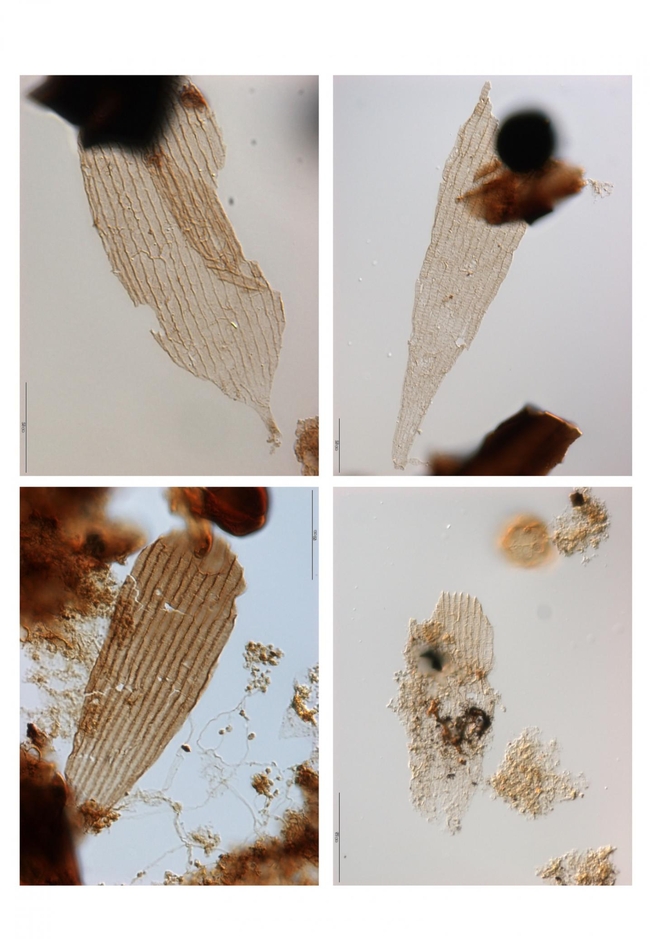
oldest insect wings
Posted on
Monday, February 12, 2018 at
6:34 AM
Control of Argentine ant in many situations, means controlling many other pests in citrus and other crops. Here is one of their techniques for their success at being so disruptive
Compounds produced by Argentine ants are used to recruit nest mates and incapacitate opponents
University of California - Riverside
RIVERSIDE, Calif. -- From their native home on the banks of South America's Paraná River, Argentine ants have conquered six continents and many oceanic islands. Their success is explained by several factors: they have more than one queen per colony, making them difficult to eradicate, and they adapt to changes in their environments by living transiently rather than building permanent nests.
Argentine ants are also highly aggressive, out-competing existing ant species for food and other resources. In a paper published today in Scientific Reports, researchers at the University of California, Riverside show how Argentine ants use chemical secretions as weapons in their interactions with harvester ants, which are native to California. The findings could help in the development of new pest control strategies.
Although they originated in a tropical ecosystem, Argentine ants are a major nuisance in California and the southern U.S., where they thrive in urban areas with artificial irrigation. They also pose natural and economic threats, competing with native ants and pollinators, and protecting plant pests such as aphids and scales in return for the sweet honeydew secretions that these insects produce.
Like many social insects, Argentine ants communicate via an assortment of chemicals that they excrete from their gaster (abdomen). During aggressive interactions, Argentine ants exhibit a behavior called gaster bending, where they place the tip of their gaster onto their opponent's body. Based on behavioral observations, researchers have long inferred that, during this interaction, Argentine ants may spray or dab irritant chemicals onto their opponent's body.
The UCR researchers confirmed this experimentally, showing that Argentine ants produce secretions containing two compounds (dolichodial and iridomyrmecin), which they apply to the surface of harvester ants during aggressive interactions. The research was led by Dong-Hwan Choe, an assistant cooperative extension specialist and assistant professor of entomology in UCR's College of Natural and Agricultural Sciences.
Choe's team investigated the effect of these compounds on harvester ants, showing they caused both irritation and disorientation. The compounds also attracted other Argentine ants to the area, allowing them to mount a larger, coordinated response to the native ant species.
"This research finding experimentally verified the long-held assumption that Argentine ants use gaster-produced compounds during aggressive interactions with other ant species. They use these compounds not only for incapacitating the opponent, but also for calling more nestmates from nearby locations for their help in combat," Choe said.
Choe said synthetic versions of these chemicals could be used to develop new pest management strategies with a greater selectivity.
"Potentially, these compounds could be used in a bait to attract Argentine ants toward a poison while at the same time acting as a deterrent to harmless native ants," he said.
###
The title of the paper is "Verification of Argentine Ant Defensive Compounds and Their Behavioral Effects on Heterospecific Competitors and Conspecific Nestmates." In addition to Choe, contributors include first author Kevin Welzel, who completed his Ph.D. in Choe's lab at UCR; Shao Hung Lee, an entomology undergraduate at UCR; Aaron Dossey at All Things Bugs, LLC; and Kamlesh Chauhan, at the USDA-Agricultural Research Service.
Cation:
Using an action called gaster bending, Argentine Ants dab irritant chemicals onto their opponent's body
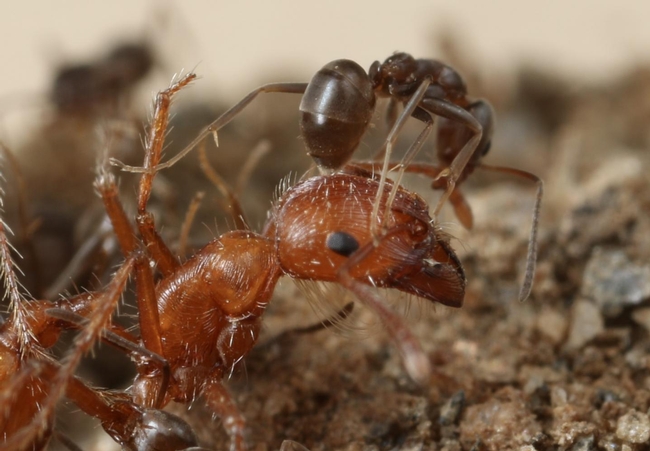
argnetine ant attacking opponent ant
Posted on
Monday, February 5, 2018 at
6:13 AM
Last May/June during a hot period and soon after fruit set, avocado growers and PCAs in the Oxnard/Camarillo area were calling in about young fruit about he size of a quarter showing up with white spots. Cutting into the fruit there might only be a small black spot just below the injury. Because that's what it is, a wound response on the part of the fruit to a physical damage. This occurred on several orchards also in the San Luis Obispo area and it seemed to happen in orchards that had recently been sprayed for avocado thrips. No piercing-sucking insects were found at any of these sites. Insects that would feed by feeding on the fruit and causing damage and malformed fruit. Insects that could typically make probing inspections of fruit prior to laying eggs. No eggs or larvae were found in the fruit. Nothing like lygus bug, BMSB, Bagrada bug or other stink bugs was found.
//ucanr.edu/blogs/blogcore/postdetail.cfm?postnum=15198
Did it have anything to do with the spray? With the hot weather? With the hot weather and the spray? With the hot weather and the insects that came with it? Did it have anything to do with the hot weather? Did it have anything to do with insects?
And then late June, the calls stopped. No more damaged fruit was being found. And then a lone call from Cayucos. Damage was found on young and older fruit. New damage seemed to be occurring on the fruit that normally sets later in that northern area. The grower walked the orchard and didn't find any bugs. The PCA swept the grove for insects. A yellow sticky card was put out.
So far, no insect has been found on the fruit. So what caused and "is" causing the damage to the fruit? It's not clear. Fruit that was damaged in Oxnard back in late May was tagged to see if it recovered. Ten fruit were flagged and two months later, those tagged fruit were still on the trees. So either the fruit that was attacked fell off with the initial damage or the fruit observed later had healed itself. Fruit have this capacity when they are actively growing to cover over damage. Often it is malformed. In most of cases with this fruit, the damage was very superficial. Occasionally, there deeper pits, but we didn't see any burrowing or tunneling.
If anyone else saw similar damage and has more to offer about this happening, I would be glad to hear about it.
Photos: Damaged fruit that was flagged and observed 2 months later.
Posted on
Monday, September 18, 2017 at
6:05 AM
Pollinator Week, June 19–25, 2017: Bee Knowledgeable!
UC Statewide IPM Program
Remember, the plant that contributes the pollen is the pollenizer (sometimes pollinzer or polleniser) and the animal that moves the pollen is the pollinator (sometimes pollenator) which doesn'talways have to be a bee, but can be another insect, bat, bird or butterfly or ....
Bees are the most important pollinators of California agriculture—helping us grow field crops, fruits, nuts, and vegetables. Honey bees receive most of the credit for crop pollination, but many other kinds of bees play an important role as well. There are 1600 species of bees in California! Take time during Pollinator Week to learn about the different kinds of bees and what you can do to help them flourish.
Why should I care about other kinds of bees?
Bees other than honey bees contribute significantly to crop pollination. For example, alfalfa pollination by alfalfa leafcutter bees is worth $7 billion per year in the United States. Other bees can also boost the result of honey bee pollination—in almond orchards, honey bees are more effective when orchard mason bees are present. The more bee species, the merrier the harvest!
While growers often rent honey bee colonies to pollinate their crops, some wild bees pollinate certain crops even better than honey bees do. For instance, bumble bees are more effective pollinators of tomato because they do something honey bees do not: they shake pollen out of flowers with a technique known as buzz pollination. Likewise, native squash bees are better pollinators of cucurbits—unlike honey bees, they start work earlier in the day, and males even sleep in flowers overnight.
How can I help honey bees and other bees?
When it comes to land management and pest management practices, some bees need more accommodations than others. That's why it is important to know what bees are present in your area and important to your crop, and plan for their needs. Use this bee monitoring guide from the University of California to identify the bees present on your farm.
You can help all kinds of bees by using integrated pest management (IPM). This means using nonchemical pest management methods (cultural, mechanical and biological control), monitoring for pests to determine whether a pesticide is needed, and choosing pesticides that are less toxic to bees whenever possible. Check out the UC IPM Bee Precaution Pesticide Ratings to learn about the risks different pesticides pose to honey bees and other bees, and follow the Best Management Practices To Protect Bees From Pesticides.
Bees also need plenty of food to stay healthy and abundant. Plant flowers that provide nectar and pollen throughout the year. See the planting resources below to find out which plants provide year-round food for specific types of bees.
Like honey bees, native bees need nesting areas to thrive. Bumble bees, squash bees, and other bees nest underground. Ground-nesting bees may require modified tilling practices (such as tilling fields no more than 6 inches deep for squash bees) or no-till management to survive. For aboveground nesters like carpenter bees and mason bees, consider planting hedgerows or placing tunnel-filled wooden blocks around the field. See the habitat resources below for more information about native bee nesting in agricultural areas.
Enjoy your “beesearch!”
Bee Habitat Resources
Sources
Bombus vosnesenskii ( say that fast) a CA native bumble bee buz pollinating a lavendar (not CA native) flower (photo: Kathy Keatley Garvey)
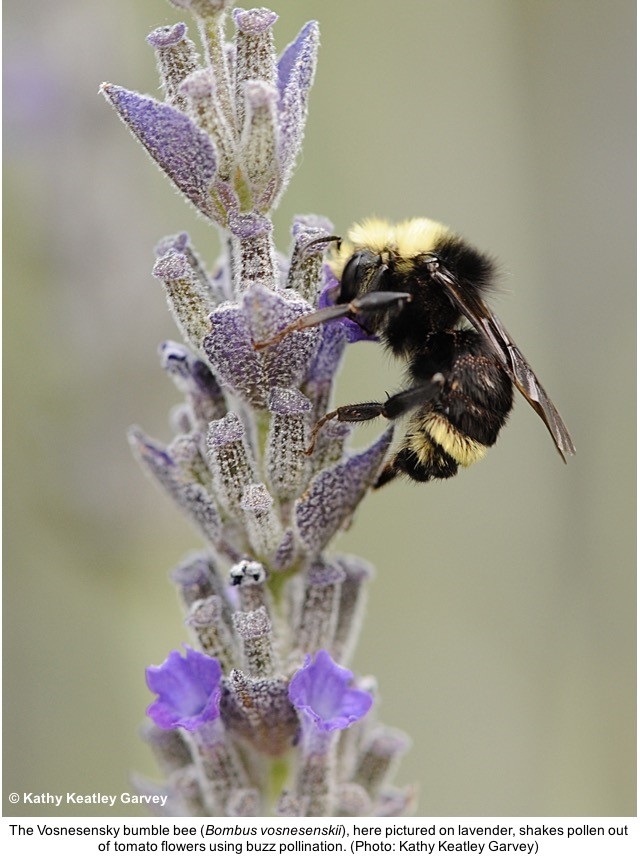
bombus vosnesenskii

bumblebee
Posted on
Thursday, June 22, 2017 at
5:56 PM
- Author:
Stephanie Parreira
Here are the top 10 blogs from Topics in Subtropics over the last 5 years. The two earliest and latest pertain to how you select products that will truly help you from amongst all those that are being promoted. Some of these have been around a long time, so that's why they are the most read. Do a Ctrl + click on the URL to read the post.
Title Author Date
A predatory mite

predatory mite
Posted on
Friday, August 14, 2015 at
1:36 PM




